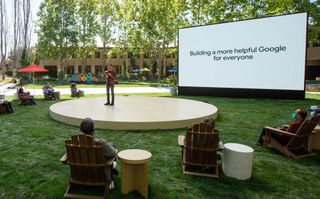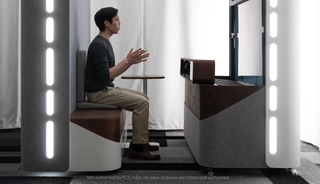Google I/O 2021: Android 12, 3D video calls, Workspace updates and more
We've rounded up all of the biggest announcements from Google's in-person developer conference

Google CEO Sundar Pichai announced a slew of new updates and features on Tuesday as the tech giant made a return to in-person events with its I/O conference held at the Mountain View Campus.
The announcements included a complete design overhaul of Android, more collaboration features for Workspace and a prototype for a 3D video conferencing booth.
"The last year has put a lot into perspective," Pichai said. "At Google, it's also given renewed purpose to our mission to organise the world's information and make it universally accessible and useful. We continue to approach that mission with a singular goal: building a more helpful Google, for everyone. That means being helpful to people in the moments that matter and giving everyone the tools to increase their knowledge, success, health and happiness."
Android 12
Android 12 boasts the biggest design overhaul in the operating system's history, according to Google. Compared with Android 11, it does indeed look drastically different with new layouts and colour schemes, many of which will be automatically changed to match the user. For example, the OS will highlight colours that are best associated with the user's wallpaper to create a personalised theme.

Google suggests it will 'feel' different too, with more responsive touch functions and smoother motion and animation thanks to a wholesale change to the underlying system. Further under-the-hood improvements also include a reduction of CPU usage that saves core system services by up to 22%.
As expected, there are more privacy controls in Android 12 that focus on data sharing with apps. This includes a new Privacy Dashboard where users can set data sharing permissions and a new indicator that lets users know when apps are accessing the microphone or camera.
Workspace
Workspace, formally known as G Suite, also got some new features, chiefly the addition of 'Smart Canvas'. This is an established product that Google is integrating into Workspace to boost collaboration in the cloud.
Get the ITPro. daily newsletter
Receive our latest news, industry updates, featured resources and more. Sign up today to receive our FREE report on AI cyber crime & security - newly updated for 2024.
Users have already been able to use it with '@-mentions' within a document that sees a smart chip offer up additional info, such as a person's name, location, job title and contact details. From now, however, the smart chip will also be available in Google Docs for recommending files and meetings. The collaboration functions will also include emoji reactions which will be added in the next few months.
Docs will also be available in a new 'pageless' format, where boundaries can be removed to create a surface that expands to fill whichever device or display is in use. This should make it easier for those working with wide tables, large images or when giving detailed feedback in comments.
There will also be more interoperability with a function to view and share Docs, Sheets and Slides directly from Meet, and content from Docs can be collaborated on from Google Chat.

Transforming business operations with AI, IoT data, and edge computing
A Pathfinder report on the ROI of AI, IoT, and edge computing
LaMDA
Pichai also revealed the company's latest research within natural language processing with a new language model for dialogue applications called LaMDA. It has an open domain, which Pichai said means it can converse on any topic, such as the planet Pluto, for example. This was showcased with pre-recorded examples, but the model should be able to give sensible responses to make learning more fun and engaging.
Google said that LaMDA was a huge step forward in natural conversation, but it's currently only trained on text. When people communicate with each other they do it across images, text, audio and video, so the plan is to improve LaMDA by building multimodal models that allow people to naturally ask questions across different types of information.
3D video chat booth
Google is also looking at ways to improve video conferencing with a 3D video chat booth called 'Project Starline'. This is only available within some of Google's offices at the moment as it is built with custom hardware and specialised equipment. It uses computer vision, machine learning, spatial audio and compression technology to transmit a live call in a way that feels more personal.

"We believe this is where person-to-person communication technology can and should go, and in time, our goal is to make this technology more affordable and accessible, including bringing some of these technological advancements into our suite of communication products," Pichai said in a blog post.
Bobby Hellard is ITPro's Reviews Editor and has worked on CloudPro and ChannelPro since 2018. In his time at ITPro, Bobby has covered stories for all the major technology companies, such as Apple, Microsoft, Amazon and Facebook, and regularly attends industry-leading events such as AWS Re:Invent and Google Cloud Next.
Bobby mainly covers hardware reviews, but you will also recognize him as the face of many of our video reviews of laptops and smartphones.





